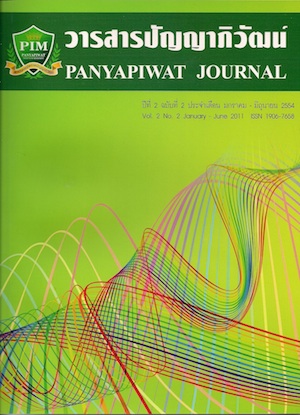ดาต้าแวร์เฮาส์และดาต้าไมนิงสำหรับการบริหาร
Main Article Content
บทคัดย่อ
บทคัดย่อ
บทความนี้ได้นำเสนอแนวคิดและการประยุกต์ใช้ดาต้าแวร์เฮาส์และดาต้าไมนิงสำหรับการบริหาร โดยสาระสำคัญคือ องค์กรที่มีข้อมูลจำนวนมากและมาจากหลายแหล่งมักประสบความยุ่งยากในการนำข้อมูลมาใช้สนับสนุนการตัดสินใจ จึงมีการพัฒนาดาต้าแวร์เฮาส์สำหรับจัดเก็บข้อมูลทั้งในอดีตและปัจจุบันให้อยู่ในรูปแบบที่เป็นมาตรฐานเดียวกันในฐานข้อมูลขนาดใหญ่ โดยมีเครื่องมือในการสืบค้น วิเคราะห์ เจาะหาข้อมูลในรายละเอียดตามช่วงเวลาได้ และหากองค์กรต้องการทราบแนวโน้มจากข้อมูลหรือความรู้ใหม่อันมีค่าซึ่งไม่เคยทราบมาก่อนจากดาต้าแวร์เฮาส์ ก็สามารถใช้เทคนิคดาต้าไมนิงเป็นเครื่องมือในการหารูปแบบและความสัมพันธ์ของข้อมูลที่ซ่อนอยู่ในฐานข้อมูลขนาดใหญ่นี้ได้เช่นเดียวกัน ดาต้าแวร์เฮาส์และดาต้าไมนิงจึงเป็นวิธีการสำคัญที่ช่วยให้องค์กรสามารถประเมินกลยุทธ์ของหน่วยงานเพื่อสร้างความได้เปรียบในการแข่งขัน หรือที่เรียกว่าธุรกิจอัจฉริยะ
คำสำคัญ : ดาต้าแวร์เฮาส์, ดาต้าไมนิง, ธุรกิจอัจฉริยะ
Abstract
This article presents a concept and applications of Data Warehouse and Data Mining in business management. Essentially, large organizations that possess a lot of data collected from many sources usually face complication in bringing the information to make decisions. Thus, Data Warehouse is invented to collect old and present data so that they are kept in the same format in the database with available tools to make query, analyze, and search for the data in a specific time period. In addition if an organization wants to understand the trend of the data or to acquire an implication from Data Warehouse, they can use Data Mining as a tool to figure the pattern or the relationship of information in the database. Data Warehouse and Data Mining are two important systems to help the organization create strategic plans to achieve competitive advantage or the so-called Business Intelligence.
Keyword : Data Warehouse, Data Mining, Business Intelligence
Article Details
“ข้าพเจ้าและผู้เขียนร่วม (ถ้ามี) ขอรับรองว่า บทความที่เสนอมานี้ยังไม่เคยได้รับการตีพิมพ์และไม่ได้อยู่ระหว่างกระบวนการพิจารณาลงตีพิมพ์ในวารสารหรือแหล่งเผยแพร่อื่นใด ข้าพเจ้าและผู้เขียนร่วมยอมรับหลักเกณฑ์การพิจารณาต้นฉบับ ทั้งยินยอมให้กองบรรณาธิการมีสิทธิ์พิจารณาและตรวจแก้ต้นฉบับได้ตามที่เห็นสมควร พร้อมนี้ขอมอบลิขสิทธิ์บทความที่ได้รับการตีพิมพ์ให้แก่สถาบันการจัดการปัญญาภิวัฒน์หากมีการฟ้องร้องเรื่องการละเมิดลิขสิทธิ์เกี่ยวกับภาพ กราฟ ข้อความส่วนใดส่วนหนึ่งและ/หรือข้อคิดเห็นที่ปรากฏในบทความข้าพเจ้าและผู้เขียนร่วมยินยอมรับผิดชอบแต่เพียงฝ่ายเดียว”
References
กฤษณะ ไวยมัย. (2548). เอกสารคำสอนวิชาคลังข้อมูลและการทำเหมืองข้อมูล. กรุงเทพฯ: ภาควิชาวิศวกรรมคอมพิวเตอร์ คณะวิศวกรรมศาสตร์ มหาวิทยาลัย เกษตรศาสตร์.
กฤษณะ ไวยมัย และคณะ. (2544). การใช้ดาต้าไมน์นิงเพื่อพัฒนาคุณภาพการศึกษาคณะวิศวกรรมศาสตร์. NECTEC technical Journal, 3(11), 134-142.
กิตติพงษ์ กลมกล่อม. (2552). การออกแบบและพัฒนาคลังข้อมูล. กรุงเทพฯ: สำนักพิมพ์ เคทีพี.
จันทร์เจ้า มงคลนาวิน และบัณฑิต เชี่ยวเจริญ. (2548). การทำเหมืองข้อมูลผู้ใช้บริการเว็บไซต์ กรณีศึกษา: HomeDD.com. จุฬาลงกรณ์ธุรกิจปริทัศน์, 27(103), 30-42.
จันทร์เจ้า สูติวราพันธ์ และชัชพงศ์ ตั้งมณี. (2545). การประยุกต์เชิงธุรกิจของเทคนิคเหมืองข้อมูล. Chulalongkorn Review, 14(56), 39-52.
จิราพร ยิ่งกว่าชาติ และคณะ. (2007). การทำนายผลสำเร็จการศึกษาของนักศึกษาระดับ อุดมศึกษาด้วยการเรียนรู้แบบเบย์และการทำเหมืองข้อมูล.เอกสารประกอบการประชุม JCSSE 2007.
ชนวัฒน์ ศรีสอ้าน. (2550). ฐานข้อมูล คลังข้อมูลและเหมืองข้อมูล.ปทุมธานี: สำนักพิมพ์มหาวิทยาลัยรังสิต.
เบญจมาศ เต็มอุดม และภัทรชัย ลลิตโรจน์วงศ์. (2545). การพัฒนาระบบคลังข้อมูล. สืบค้นเมื่อ 14 กุมภาพันธ์ 2554, จากศูนย์เทคโนโลยีอิเล็กทรอนิกส์และคอมพิวเตอร์แห่งชาติ เว็บไซต์: http://www.nectec.or.th/pub/book/2004-6-4-323380-dataWare.pdf
ภาณุ ตันโสรัจประเสริฐ. (2546). การพัฒนาระบบตรวจสอบการซื้อขายหลักทรัพย์ที่ผิดปกติสำหรับบริษัทหลักทรัพย์ในประเทศโดยการใช้ดาต้าไมนิง.ปริญญานิพนธ์วิทยาศาสตรมหาบัณฑิต. จุฬาลงกรณ์มหาวิทยาลัย.
วิญญู ละอองสุวรรณ. (2544). การออกแบบและพัฒนาขั้นตอนวิธีการวิเคราะห์บันทึกการเข้าใช้โดยใช้เทคนิคการทำเหมืองข้อมูล. ปริญญานิพนธ์วิทยาศาสตรมหาบัณฑิต, จุฬาลงกรณ์มหาวิทยาลัย.
Baltzan, Paige & Phillips, Amy. (2009). Business driven information systems. New York: McGraw-Hill/Irwin.
Berry, Michael & Linoff, Gordon. (1997). Data mining techniques: for marketing, sales, and customer support. USA: John Wiley & Sons.
Feldman, Ronen & Sanger, James. (2007). The text mining handbook advanced approaches in analyzing unstructured data. New York: Cambridge University Press.
Ghani, Rayid. (2003). Mining the web to add semantics to retail data mining. Proceedings of EWMF’ 2003.
Han, Jiawei & Kamber, Micheline. (2001). Data mining: concepts and techniques. San Francisco: Morgan Kaufmann Publishers.
Inmon, W. H., & R. D. Hackathorn. (1994). Using the Data warehouse. New York: Wiley.
Inyaem, Uraiwan, Meesad, Phayung, Haruechai-yasak, Choochart and Tran, Dat. (2010). Terrorism event classification using fuzzy inference systems. International Journal of Computer Science and Information Security, 7(3), 247-256.
ITM0408. (2554). Data warehouse & data mining. สืบค้นเมื่อ 14 กุมภาพันธ์ 2554. จาก Technology เว็บไซต์ http://itm0408.blogspot.com/2010/08/data-warehouse-data-mining.html
Kargupta, Hillol, Han, Jiawei, Yu, Philip S., Motwani, Rajeev and Kumar, Vipin. (2009). Next generation of data mining. Minnesota: Chapman & Hall/CRC.
Kimball, Ralph. (1996). The data warehouse toolkit. USA: John Wiley.
Kongthon, Alisa, Kongyoung, Sarawoot Sangkeettrakarn, Chatchawal Haruechaiyasak, Choochart. (2010). Thailand’s Tourism Information Service Based on Semantic Search and Opinion Mining. Proceedings of ITC-CSCC 2010.
Nakauchi, Yasushi. (2009). Sequential pattern mining for cooking - support robot. Intel-ligence Environments Methods, Algorithms and Applications, 51-67.
Turban, Efraim, E.Aronson, Jay, Liang, Ting-Peng, Sharda, Ramesh. (2007). Decision support and intelligence systems. New Jersy: Pearson Prentice Hall.
Weldon, J. L. (1996). Data mining and visualiza-tion. Database Programming and Design, 9(5), 21-24.

